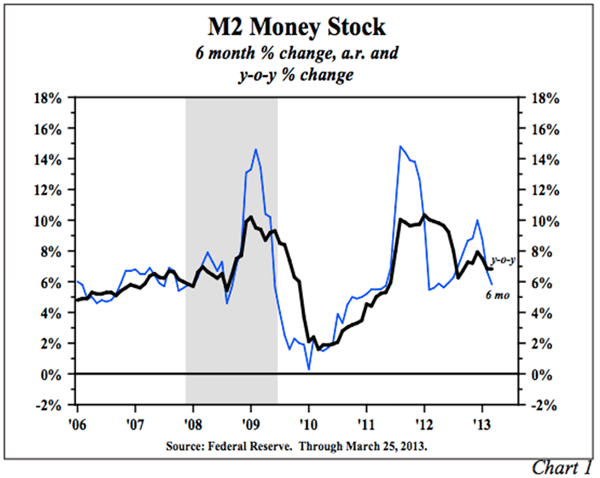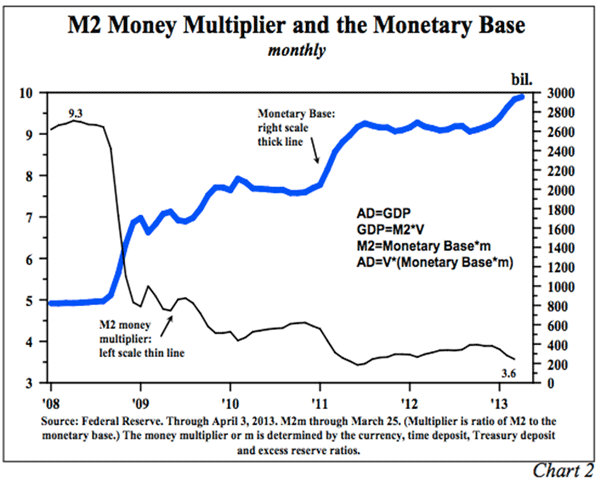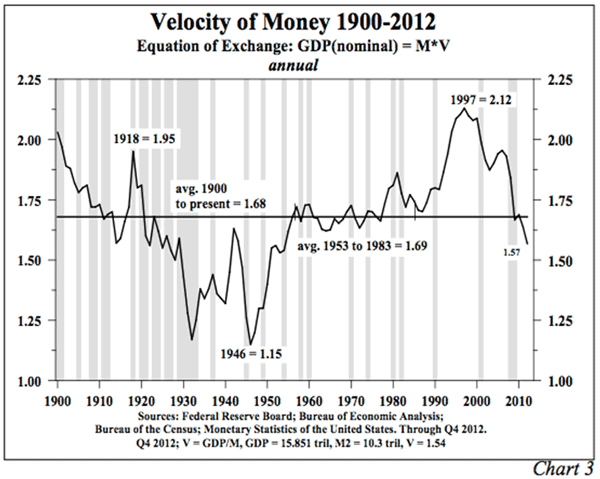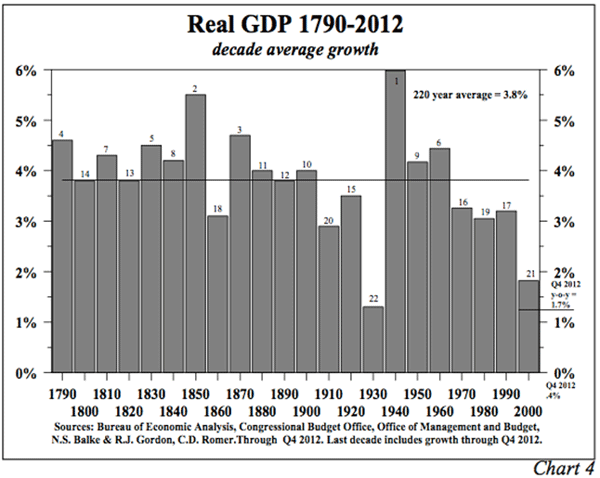The Fed's Money Printing Flaw, Velocity and No Inflation
Economics / US Economy Apr 24, 2013 - 12:56 PM GMTBy: John_Mauldin
 Lacy Hunt and Van Hoisington launch into their first-quarter "Review and Outlook," this week's Outside the Box, with a statement that some may find eye-opening: "The Federal Reserve (Fed) is not, and has not been, 'printing money'…" But given the facts of life about how money is really created (and destroyed), they are of course right: it's all about the acceleration – or deceleration – in the M2 money supply.
Lacy Hunt and Van Hoisington launch into their first-quarter "Review and Outlook," this week's Outside the Box, with a statement that some may find eye-opening: "The Federal Reserve (Fed) is not, and has not been, 'printing money'…" But given the facts of life about how money is really created (and destroyed), they are of course right: it's all about the acceleration – or deceleration – in the M2 money supply.
But there are deeper currents here. For, as Van and Lacy say, "A review of post-war economic history would lead to a logical assumption that the money supply (M2) would respond upward to [the Fed's] massive infusion of reserves into the banking system. And yet, the Fed's 3.5x expansion of the monetary base over the past five years has only grown M2 by 35%, and year-over-year growth through March, 2013, was less than 7%. "In other words," say our authors, "there is no evidence that the massive security purchases by the Fed have resulted in a sustained acceleration in monetary growth; nor is there evidence that economic conditions have improved."
So what is wrong with this picture? Well, it turns out that not only can the Fed not control the money supply, it can't control the velocity of money either. And that means the Fed can't create rising aggregate demand. As in, Ben's shooting blanks.
To help us get our heads around this fundamental realization, Van and Lacy lead us deeper into the gooey cytoplasm of Federal Reserve genetics; but the bottom line, as Prof. Irving Fisher taught us, is that GDP = MV. That is, nominal GDP equals money times its turnover (velocity). And don't look now, but velocity is the lowest it's been in six decades.
The upshot (downshot?) is that the decade just past saw a growth rate worse than any in US history, except the 1930s. We already knew that, but it's good to have estimable gentlemen like Messrs. Hunt and Hoisington bring us the numbers and solid analysis to back up the surprising statements we find ourselves forced to make about this oh-so-Muddle Through Economy.
Hoisington Investment Management Company (www.Hoisingtonmgt.com) is a registered investment advisor specializing in fixed-income portfolios for large institutional clients. Located in Austin, Texas, the firm has over $5 billion under management and is the sub-adviser of the Wasatch-Hoisington U.S. Treasury Fund (WHOSX).
I am back in Dallas for a week and getting ready for my conference next week, preparing a brand-new presentation, working on books, looking through architectural plans, spending time with family, dealing with endless minutiae, and all the while trying to stay caught up with my reading. Life seems so much busier than a decade or so ago when I had seven kids at home and a growing business, was deeply involved in politics, and was limited to old-fashioned publications on paper as the sources for my research. I am not complaining, mind you, as I am having a marvelous time; I just wonder how I would have done back then what I do now.,
I am really looking forward to my conference next week. This will be our (Altegris and my) 10th conference. From the beginning I have always invited speakers I wanted to hear and who would challenge my thinking. This is about our best line-up ever, and I really would put it up against the roster of any conference anywhere. Most conferences have a few “headliners” and then other speakers, many of whom pay to sponsor and speak. We have nothing but headliners. My only regret is that we could not go for a couple more days and bring in a few more names.
I know some people look at our line-up of speakers and see mostly bears, but I think the attendees are in for a surprise. I am looking at PowerPoints and letters from the presenters, and the large majority of them are finding places to put capital to work. This dynamic is going to make for some lively debates at the conference. You can learn more at www.altegris.com/sic .
Two final thoughts. Given how much I travel it may be self-serving, but I find it inexcusable that the FAA would blame “sequestration” on the cutback in air-traffic controllers, etc. In a federal budget that large, they could find a few dollars to keep things rolling. That Congress would allow this without requiring prioritization funds is just one example – out of thousands – of the executive branch saying, “See, if you don’t give us money we will just inconvenience you,” all the while funding programs that we could well do without They might also take a look at cutting and rearranging budgets, as any normal business would do, to make sure that the important work for their customers gets done.
And finally, I have to apologize to my British friends. I am appalled that the current administration did not send a few officials to the funeral of Dame Margaret Thatcher. So much has been written about her that there is little I can add. I understand that some in the current administration might not agree with her policies, but an official acknowledgement of the “special relationship” that exists between Britain and the US would have seemed to require the presence of a representative from our government. That none were dispatched causes me to feel great shame for our country. Is this the way we treat our friends? It speaks volumes.
Have a great week. And are you paying attention to Italy? It seems that whom the gods would drive mad they first send to Italy to study politics.
Your needing to go back to Tuscany analyst,
John Mauldin, EditorOutside the Box
JohnMauldin@2000wave.com
Hoisington Investment Management – Quarterly Review and Outlook, First Quarter 2013
Printing Money
“The Federal Reserve is printing money”. No statement could be less truthful. The Federal Reserve (Fed) is not, and has not been, “printing money” as defined as an acceleration in M2 or money supply. Just check the facts. For the first quarter of 2013 the Fed purchased $277.5 billion in securities (net) as their security portfolio expanded from $2.660 trillion to $2.937 trillion. A review of post-war economic history would lead to a logical assumption that the money supply (M2) would respond upward to this massive infusion of reserves into the banking system. The reality is just the opposite. The last week of December, 2012 showed M2 at $10.505 trillion, but at the end of March, 2013 it totaled only $10.450 trillion which was an unexpected decline of $55 billion. Printing money? No.
This broad misconception of the Fed’s ability to print money has been widely embraced since the Fed began its massive balance sheet expansion near the end of 2008. It was then that the Fed expanded the monetary base from $840 billion to $1.7 trillion in a matter of months. Further, from the initiation of this misguided program to the end of March 2013, the Fed has expanded the monetary base from $840 billion to $2.93 trillion. The money supply indeed went up (35%) but not in proportion to the increase in the monetary base (249%). Presently, the year- over- year expansion of M2 is only 6.8%, which is nearly identical to its year-over-year growth rate in March of 2008 before the Fed decided to “help out the economy” (Chart 1). In other words, there is no evidence that the massive security purchases by the Fed have resulted in a sustained acceleration in monetary growth; nor is there evidence that economic conditions have improved.
The Fed's Flaw
Not only does the Fed not control money, but it cannot determine velocity (V), the speed that money turns over, either. The great American economist, Irving Fisher, identified this connectivity between money and economic growth with a straightforward formula: Nominal GDP equals money (as defined by M2) times its turnover (GDP=MV). Two flaws exist in the belief that the Fed can create rising aggregate demand. First, they do not directly control M2. Second, velocity is almost entirely outside their control. In order to understand how these two variables prevent the Fed from increasing aggregate demand, it is necessary to become conversant with a few terms: monetary base, bank reserves, and money multiplier.

The monetary base, which is derived from a consolidated balance sheet of the Fed and Treasury, has an asset (source side), and a liability (use side). When the Fed purchases government securities, the asset side rises and the liability side, comprised of currency in circulation and bank reserves, increases commensurately. Bank reserves are funds that are held by banks on deposit at the Fed or in their own institution in the form of vault cash. These funds, or reserves, are available for lending. This process of lending reserves creates deposits and currency that constitute the definition of M2.
The monetary base is often referred to as “high-powered money” since the reserve component has the potential to expand deposits and therefore money. The operative word is potential, which may or may not be realized. The massive reserve injection since 2008 is therefore the primary reason why there has been an elevated fear of inflation since these funds could be loaned. However, the empirical evidence is clear that high- powered money is not causing an increase in M2. Why? A bank’s conversion of reserves into money is called the money multiplier (Chart 2, left scale). At the end of 2007, the money multiplier was 9.0. That meant that the monetary base of $825 billion (Chart 2, right scale) was multiplied nine times to create the level of M2 that stood at $7.4 trillion. At the end of March, 2013 the monetary base had exploded to $2.9 trillion, but the money multiplier had collapsed to only 3.6, creating an M2 balance of $10.4 trillion. The Central Ban k has very little control over the movement of the money multiplier; the actions of the banks and their customers primarily control this variable. This lack of control was evident in the first quarter of 2013 when the monetary base rose by $264 billion and M2 fell because the money multiplier declined from 3.9 to 3.6. Therefore, the Fed’s balance sheet expansion was thwarted.

Velocity
Referring back to Fisher’s equation GDP=MV, the other constraint on the Fed's ability to increase aggregate demand is velocity. If M2 actually expands, then velocity must remain stable in order for nominal GDP to be lifted in proportion to the rise of M2. While stable velocity was assumed in most of the post war academic work on monetary theory, clear empirical evidence is that velocity is woefully unstable (Chart 3). A host of factors influence velocity, but arguably the most important one is the type of borrowing and lending that occurs. For velocity to rise, any increase in debt needs to create a productive income stream. For the past several years, most of the borrowing and lending activities have related to daily consumptive needs, including borrowing by the federal government as well as much of the recent upturn in consumer lending. Borrowing to finance consumption does not generate a productive income stream nor does it create the resources to repay the borrowed funds. Consequently, velocity has collapsed and now stands at a six decade low.

No Inflation
Inflation cannot ignite in such an environment. Incomes will languish and growth in aggregate demand, as measured by nominal GDP, will slow except for brief, intermittent periods. Some inflationists point to the vast pool of reserves and conclude that if borrowing and lending begin to accelerate, money will surge and so will nominal GDP, but this argument is invalid. First, the money multiplier could continue to contract, just as the most recent figures confirm. Even if, contrary to the latest data, the money multiplier were to stabilize, an extended period would still transpire before any meaningful change in economic conditions. Second, no sign suggests that credit creation is turning more productive. Hence, velocity will continue to fall. Research further indicates that there is a considerable lag between monetary change and altered economic conditions.
In the current setting, those historically long lags should be even longer. The intersection of the aggregate demand curve (AD) with the aggregate supply curve (AS) determines the price level and real GDP. In today’s highly globalized markets, with services coming on-stream from all parts of the world, the AS curve could be in the process of continually shifting outward. Thus, the price level could fall even if there are small outward shifts in the aggregate demand curve. Additionally, the extreme level of indebtedness is a force entirely independent of the Fed, and it is restraining aggregate demand and serving to neutralize what minimal influence the Fed has on the economy. Moreover, this year’s tax hike will serve to shift the aggregate demand curve inward, reducing demand, providing a second powerful counter-force to the Fed’s feeble actions.
Perspective
Our present economic situation is nearly unparalleled in American history (Chart 4). An examination of the real economic growth rate of each decade in the United States from 1790 to 2012 reveals the unprecedented sluggishness of our present economic environment. The 1.8% average rise in the thirteen years of this century is less than half of the 3.8% growth rate since 1790. The only decade that witnessed worse economic conditions was, of course, the 1930s.

Debt Constrains Growth
Bad things happen when government debt exceeds 100% of GDP. Four studies published in just the past three years document this conclusion. These studies are highly relevant since OECD figures indicate that gross government debt exceeds 100% in the U.S., Europe, Japan as well as in other OECD member countries. Three of these studies were conducted by foreign scholars and published outside the United States thus avoiding attachment to the unfortunate domestic political debate. Here are the studies, starting with the one with the broadest implications:
(1) In Government Size and Growth: A Survey and Interpretation of the Evidence, Swedish economists Andreas Bergh and Magnus Henrekson find a “significant negative correlation” between size of government and economic growth.
Specifically, “an increase in government size by 10 percentage points is associated with a 0.5% to 1% lower annual growth rate.” (Journal of Economic Surveys, April, 2011)
(2) In The Impact of High and Growing Government Debt on Economic Growth, An Empirical Investigation for The Euro Area, Cristina Checherita and Philipp Rother find that a government debt to GDP ratio above the turning point of 90-100% has a “deleterious” impact on long-term growth. Additionally, the impact of debt on growth is non-linear. This means that as the government debt rises to higher and higher levels, the adverse growth consequences accelerate. (European Central Bank, Working Paper 1237, August 2010)
(3) In The Real Effects of Debt, Stephen G. Cecchetti, M.S. Mohanty and Fabrizio Zampolli determine “beyond a certain level, debt is bad for growth. For government debt, the number is about 85% of GDP.” (Bank for International Settlements (BIS) in Basel, Switzerland, September, 2011)
(4) In Debt Overhangs: Past and Present - Post 1800 Episodes Characterized by Public Debt to GDP Levels Exceeding 90% for At Least Five Years, Carmen M. Reinhart, Vincent R. Reinhart and Kenneth S. Rogoff confirm that public debt overhang episodes are associated with growth over one percent lower than during other periods, and such episodes lasted an average of 23 years. They write “the long duration also implies that cumulative shortfall in output from debt overhang is potentially massive”. (National Bureau of Economic Research, Working Paper 18015, August 2012)
When private debt to GDP rises above 160% to 175% of GDP, growth is also stunted. This argument is also operative since private debt to GDP in the U.S. was 260% of GDP as of the fourth quarter of 2012. The point on private debt is a serious matter since it strikes at one of the core purposes of central banking – to promote private credit growth. But this is only valid for normal considerations and not when private debt is excessively high. When private debt is excessive, efforts to promote more private debt are counterproductive, thus the Fed is destabilizing rather than facilitating economic growth. The two major studies on private debt, both completed in the past two years and published outside the United States, bear directly on this issue. The first is the 2011 United Nations Conference on Trade and Development (UNCTAD) study, Too Much Finance, authored by Jean Louis Arcand, Enrico Berkes and Ugo Panizza. They find a negative effect on output growt h when credit to private sector reaches 104% to 110% of GDP. The strongest adverse effects are for credit over 160% of GDP. The second is the 2011 BIS study referenced above. It finds that these negative consequences, or what the BIS economic advisor Cecchetti refers to as the point at which debt levels turn “cancerous”, start at 175% just slightly more than the UNCTAD study.
Is Deflation a Continuing Risk?
In their pioneering work, This Time is Different, Carmen Reinhardt and Kenneth Rogoff (R&R) found that “In Depression-era defaults, deflation was the norm.” They, however, observed situations where extreme over indebtedness was followed by high inflation. For all its valuable contributions, R&R’s sample in this best selling 2009 book included both advanced and emerging economies. In later studies other researchers also separated advanced from emerging economies because the latter have options that the former do not. The emerging markets and very small economies in general can resort to currency devaluation when they become over-indebted which creates domestic inflation. Such adversarial action may succeed because the individual countries are too small and insignificant to harm others and thus would not evoke immediate retaliation. But inflation is optional for these smaller countries only. If advanced economies choose currency deval uation ("economic warfare") to deal with a debt overhang, this evokes retaliation and a “race to the bottom” that is globally deflationary (the 1927 to 1939 experience). As far as we know, all the debt studies of the past three years have confined statistical examination to the data on advanced economies, a procedure that is now widely supported.
Irrationality
Credible academic research indicates that economic growth deteriorates when debt to GDP reaches critical levels - a condition that has now been met in countries that represent 75% of global GDP. When this reality is coupled with the Fed’s inability to create money growth or inflation, the result will invariably be slow nominal GDP growth.
The financial and other markets do not seem to reflect this reality of subdued growth. Stock prices are high, or at least back to levels reached more than a decade ago, and bond yields contain a significant inflationary expectations premium. Stock and commodity prices have risen in concert with the announcement of QE1, QE2 and QE3. Theoretically, as well as from a long-term historical perspective, a mechanical link between an expansion of the Fed’s balance sheet and these markets is lacking. It is possible to conclude, therefore, that psychology typical of irrational market behavior is at play. This suggests that when expectations shift from inflation to deflation, irrational behavior might adjust risk asset prices significantly. Such signs that a shift is beginning can be viewed in the commodity markets. The CRB Commodity Index peaked about two years ago at 691, but now stands at 551, a 20% decline despite massive Fed balance sheet expansion. The ability of th e Fed to arrest a downside irrational move in risk assets may be limited. Non-risk assets, such as long dated U.S. treasuries, should benefit from this shift in perception.
Van R. Hoisington Lacy H. Hunt, Ph.D.
John Mauldin
subscribers@MauldinEconomics.com
Outside the Box is a free weekly economic e-letter by best-selling author and renowned financial expert, John Mauldin. You can learn more and get your free subscription by visiting www.JohnMauldin.com.
Please write to johnmauldin@2000wave.com to inform us of any reproductions, including when and where copy will be reproduced. You must keep the letter intact, from introduction to disclaimers. If you would like to quote brief portions only, please reference www.JohnMauldin.com.
John Mauldin, Best-Selling author and recognized financial expert, is also editor of the free Thoughts From the Frontline that goes to over 1 million readers each week. For more information on John or his FREE weekly economic letter go to: http://www.frontlinethoughts.com/
To subscribe to John Mauldin's E-Letter please click here:http://www.frontlinethoughts.com/subscribe.asp
Copyright 2013 John Mauldin. All Rights Reserved
Note: John Mauldin is the President of Millennium Wave Advisors, LLC (MWA), which is an investment advisory firm registered with multiple states. John Mauldin is a registered representative of Millennium Wave Securities, LLC, (MWS), an FINRA registered broker-dealer. MWS is also a Commodity Pool Operator (CPO) and a Commodity Trading Advisor (CTA) registered with the CFTC, as well as an Introducing Broker (IB). Millennium Wave Investments is a dba of MWA LLC and MWS LLC. Millennium Wave Investments cooperates in the consulting on and marketing of private investment offerings with other independent firms such as Altegris Investments; Absolute Return Partners, LLP; Plexus Asset Management; Fynn Capital; and Nicola Wealth Management. Funds recommended by Mauldin may pay a portion of their fees to these independent firms, who will share 1/3 of those fees with MWS and thus with Mauldin. Any views expressed herein are provided for information purposes only and should not be construed in any way as an offer, an endorsement, or inducement to invest with any CTA, fund, or program mentioned here or elsewhere. Before seeking any advisor's services or making an investment in a fund, investors must read and examine thoroughly the respective disclosure document or offering memorandum. Since these firms and Mauldin receive fees from the funds they recommend/market, they only recommend/market products with which they have been able to negotiate fee arrangements.
Opinions expressed in these reports may change without prior notice. John Mauldin and/or the staffs at Millennium Wave Advisors, LLC and InvestorsInsight Publishing, Inc. ("InvestorsInsight") may or may not have investments in any funds cited above.
Disclaimer PAST RESULTS ARE NOT INDICATIVE OF FUTURE RESULTS. THERE IS RISK OF LOSS AS WELL AS THE OPPORTUNITY FOR GAIN WHEN INVESTING IN MANAGED FUNDS. WHEN CONSIDERING ALTERNATIVE INVESTMENTS, INCLUDING HEDGE FUNDS, YOU SHOULD CONSIDER VARIOUS RISKS INCLUDING THE FACT THAT SOME PRODUCTS: OFTEN ENGAGE IN LEVERAGING AND OTHER SPECULATIVE INVESTMENT PRACTICES THAT MAY INCREASE THE RISK OF INVESTMENT LOSS, CAN BE ILLIQUID, ARE NOT REQUIRED TO PROVIDE PERIODIC PRICING OR VALUATION INFORMATION TO INVESTORS, MAY INVOLVE COMPLEX TAX STRUCTURES AND DELAYS IN DISTRIBUTING IMPORTANT TAX INFORMATION, ARE NOT SUBJECT TO THE SAME REGULATORY REQUIREMENTS AS MUTUAL FUNDS, OFTEN CHARGE HIGH FEES, AND IN MANY CASES THE UNDERLYING INVESTMENTS ARE NOT TRANSPARENT AND ARE KNOWN ONLY TO THE INVESTMENT MANAGER.
John Mauldin Archive |
© 2005-2022 http://www.MarketOracle.co.uk - The Market Oracle is a FREE Daily Financial Markets Analysis & Forecasting online publication.



